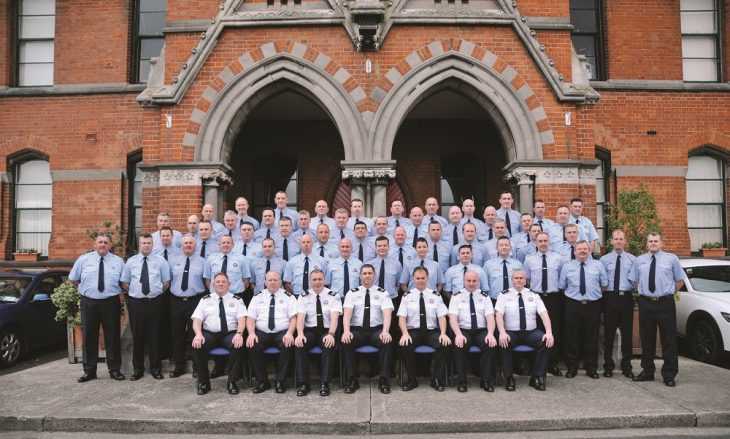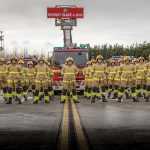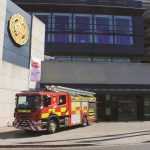Pictured are the 50 sub officers who graduated in May, along with the team of instructors led by D/O Robert Tierney
Among the latest graduates from the O’Brien Training Institute are 50 new sub officers, who have completed the junior officer course.
Dublin Fire Brigade’s training centre in Marino is a whirlwind of activity these days, as recruit classes undergo their introduction to the world of firefighting, serving personnel pass through for continuous professional development, and external organisations take part in courses like occupational first aid. Among those passing through the training institute earlier this year was a group of newly promoted sub officers, completing the junior officer course in advance of deployment in their new roles.
A total of 48 full-time and two retained sub officers took part in the intensive two-week course, following a rigorous and robust selection process. Covering a variety of knowledge and expertise required of a sub officer, the overarching theme is the structure and management plan of Dublin Fire Brigade, and the position of the sub officer in the chain of command.
“The areas we cover are methods of instruction – they have a paramount role within the organisation in the stations, delivering lectures, delivering and supervising training. So it’s important they have an understanding of the health and safety of firefighters and the ability to deliver training. We teach them how to do that,” explains course director D/O Rob Tierney. “It’s the biggest junior officer course ever done in Dublin Fire Brigade. Logistically it was quite demanding, but I had a great team around me, especially the officers that I had asked to be here on the course. But also the support staff in the OBI, considering that they also had 50 recruits training here. At some stages there were 200 people here during the day, but I’m pleased to say that it went very well. It’s great to see so many people progress through the ranks in one group. Historically you have smaller groups, perhaps of 20-30 people, but to see 50 new officers in a room is fantastic progress for Dublin Fire Brigade and Dublin City Council.”
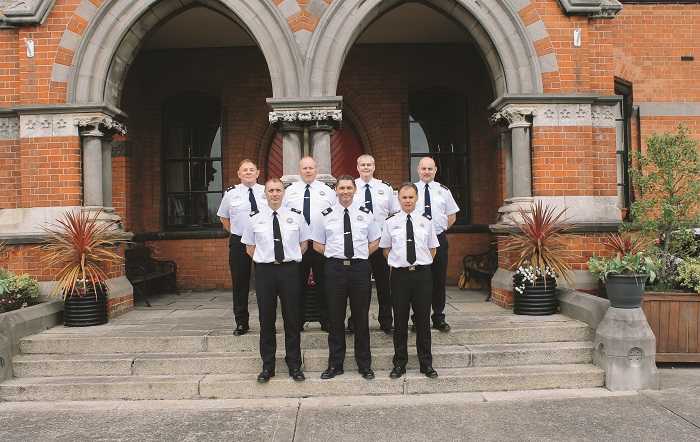
The team of course instructors. FRONT (L-R): D/O W. Maher, D/O R. Tierney, D/O P Hendricken. BACK (L-R): S/O R. Currie, S/O S. Dillon, S/O P. Sherlock, S/O M/ Cooke
Coursework
A number of instructors were seconded to the OBI for the purposes of this course, some from operational duty and others working in the training centre. Alpha district D/O Willie Maher was one of the former, chosen for his experience with DFB’s hazmat response capabilities. Though hazmat incidents are perhaps less frequent than others, sub officers play an important role in these and other events, dealing with smaller incidents as the incident commander, filling the role of sector commander at larger scenes, managing resources or provide reports along the chain of command.
“Equally they would have to look after their own crews, wearing of correct PPC, identifying that it’s a hazmat incident, making use of the information resources that we would have at a scene. They’ve been given a general overview of all the different skills they might be called upon to manage at a hazmat incident, big or small,” D/O Maher says. “I think the students themselves have stepped up to the plate as regards their professionalism, their punctuality, their dress, and it has been noticed by the other courses. These people are taking on this challenge and they are progressing, they’re fully engaged with the process. The questions they have asked in the lessons are very appropriate, very apt, and there was good engagement with the students on the course. There was a definite desire for learning.”
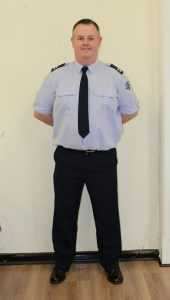
Tom Gallagher
Changing roles
The motivation behind the students’ move from firefighter to sub officer is varied, from a desire to have more responsibility to a chance to experience other facets of the job. Others are seeking a change in their careers, looking for new challenges. “I’m in my twentieth year in the job – Tallaght for 13 years and Tara Street for seven. It’s time for a career change, I’ve done firefighting for 20 years now, I want to move onto the next step,” says Sub Officer Tom Gallagher. “I’m apprehensive but looking forward to it! I was in the acting position a good bit in the last year in my own station, so I have an idea of what is expected of me. I’m looking forward to it – a new station again.”
For Sub Officer Niall Grant, a 20-year veteran of the brigade, it’s a chance to maintain his interest in the job. Having worked at a number of stations throughout the past two decades, absorbing as much as he could, progressing to junior management is a logical progression. “As a firefighter you can go to different stations on transfer, you can absorb as much as you can either on the ambulance or within a role as a senior firefighter,” he says. “But at a certain stage of your career, it’s going to come to an end… I would have gone from station to station to always keep fresh, I’ve done an awful lot within that window of 20 years as a firefighter. And now this is just another station to refresh in the job and take it to another level.”
The new sub officers are beginning life in their new stations, in new roles that require new and more advanced responsibilities. The course might be finished, but their education is ongoing. “This development course has been full on, we’ve received over 40 lectures on a wide variety of topics,” explains Caroline Gunning, who has been with the brigade for the past 17 years. “There’s a lot to take in. We’ve had really good instruction so we’re taking away a big toolkit, and we’ll learn as we go on.”
Instructor Stephen Dillon, a Station Officer in Foxtrot District, is proud of the class and believes they will prove valuable to the brigade in the years ahead. “I’ve worked with many of these guys – I’ve worked with them through different watches through my career,” he explains. “A great asset to Dublin Fire Brigade, one and all.”

